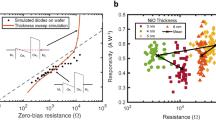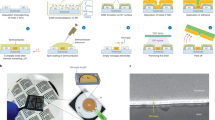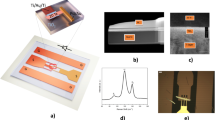Abstract
Amain focus of research on organic semiconductors is their potential application in passive organic radio-frequency identification (RF-ID) tags. First prototypes working at 125 kHz have been shown by industrial research groups1. However, to be commercially viable, the organic RF-ID tag would need to be compatible with the base-carrier frequency of 13.56 MHz (ref. 2). High-frequency operation has been out of reach for devices based on organic semiconducting material, because of the intrinsically low mobility of those materials. Here, we report on a rectifier based on a pentacene diode that can rectify an incoming a.c. signal at 50 MHz. At 14 MHz, a rectified voltage of 11 V for an a.c. voltage with a peak-to-peak amplitude of 36 V has been achieved. On the basis of those results, we estimate the frequency limits of an organic diode showing that even the ultra-high-frequency band at around 800 MHz is within reach.
This is a preview of subscription content, access via your institution
Access options
Subscribe to this journal
Receive 12 print issues and online access
$259.00 per year
only $21.58 per issue
Buy this article
- Purchase on Springer Link
- Instant access to full article PDF
Prices may be subject to local taxes which are calculated during checkout




Similar content being viewed by others
References
Baude, P. F. et al. Pentacene-based radio-frequency identification circuitry. Appl. Phys. Lett. 82, 3964–3966 (2003).
Finkenzeller, K. RFID Handbook Vol. 1 Ch. 5, 114 (Wiley, New York, 2002).
De Leeuw, D. Identification transponder. US Patent WO99/30432 (1999).
Ma, L., Ouyang, J. & Yang, Y. High-speed and high-current density C60 diodes. Appl. Phys. Lett. 84, 4786–4788 (2004).
Karg, S., Meier, M. & Riess, W. Light-emitting diodes based on poly-p-phenylene-vinylene: I. Charge-carrier injection and transport. J. Appl. Phys. 82, 1951–1960 (1997).
Roman, L. S., Berggren, M. & Inganäs, O. Polymer diodes with high rectification. Appl. Phys. Lett. 75, 3557–3559 (1999).
Hu, W., Gompf, B., Pflaum, J., Schweitzer, D. & Dressel, M. Transport properties of [2,2]-paracyclophane thin films. Appl. Phys. Lett. 84, 4720–4722 (2004).
Gao, W. & Kahn, A. Electronic structure and current injection in zinc phthalocyanine doped with tetrafluorotetracyanoquinodimethane: Interface versus bulk effects. Org. Electron. 3, 53–63 (2002).
Tanase, C., Meijer, E. J., Blom, P. W. M. & De Leeuw, D. M. Unification of the hole transport in polymeric field-effect transistors and light-emitting diodes. Phys. Rev. Lett. 91, 216601 (2003).
Pope, M. & Swenberg, C. E. Electronic Processes in Organic Crystals and Polymers 2nd edn Vol. 1 Ch. VI, 663 (Oxford Univ. Press, New York, Oxford, 1999).
Koch, N., Elschner, A., Schwartz, J. & Kahn, A. Organic molecular films on gold versus conducting polymer: Influence of injection barrier height and morphology on current-voltage characteristics. Appl. Phys. Lett. 82, 2281–2283 (2003).
Yamamoto, H., Kasajima, H., Yokoyama, W., Sasabe, H. & Adachi, C. Extremely-high-density carrier injection and transport over 12000 A/cm2 into organic thin films. Appl. Phys. Lett. 86, 083502 (2005).
Crone, B. K. et al. Organic oscillator and adaptive amplifier circuits for chemical vapor sensing. J. Appl. Phys. 91, 10140 (2002).
Klauk, H. et al. Pentacene organic transistors and ring oscillators on glass and on flexible polymeric substrates. Appl. Phys. Lett. 82, 4175–4177 (2003).
Kelley, T. W., Muyres, D. V., Baude, P. F., Smith, T. P. & Jones, T. D. High performance organic-thin-film transistors. Mater. Res. Soc. Symp. Proc. 771, L6.5.1.–L6.5.10 (2003).
De Vusser, S., Steudel, S., Myny, K., Genoe, J. & Heremans, P. High performance, low voltage organic thin-film transistors and circuits. Mater. Res. Soc. Symp. Proc. E 870, H1.4.1–H1.4.6 (2005).
Lampert, M. A. & Mark, P. Current Injection in Solids (Academic, New York, 1970).
Acknowledgements
This work was partially supported by the European-funded Integrated Project POLYAPPLY (IST No. 507143).
Author information
Authors and Affiliations
Corresponding author
Ethics declarations
Competing interests
The authors declare no competing financial interests.
Rights and permissions
About this article
Cite this article
Steudel, S., Myny, K., Arkhipov, V. et al. 50 MHz rectifier based on an organic diode. Nature Mater 4, 597–600 (2005). https://doi.org/10.1038/nmat1434
Received:
Accepted:
Published:
Issue Date:
DOI: https://doi.org/10.1038/nmat1434
This article is cited by
-
Ultralow contact resistance in organic transistors via orbital hybridization
Nature Communications (2023)
-
Rapid and up-scalable manufacturing of gigahertz nanogap diodes
Nature Communications (2022)
-
On-chip integrated process-programmable sub-10 nm thick molecular devices switching between photomultiplication and memristive behaviour
Nature Communications (2022)
-
Influence of SAM Quality on the Organic Semiconductor Thin Film Gas Sensors
Chemical Research in Chinese Universities (2022)
-
Imperceptible energy harvesting device and biomedical sensor based on ultraflexible ferroelectric transducers and organic diodes
Nature Communications (2021)



